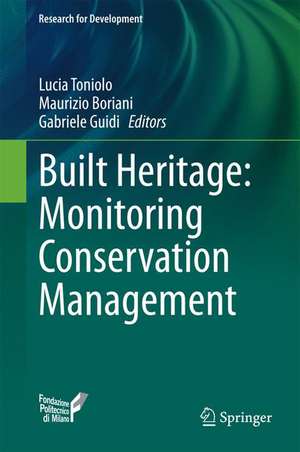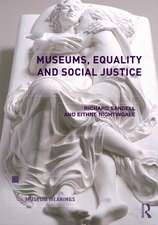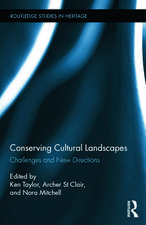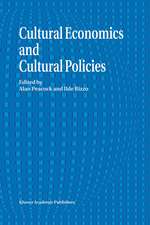Built Heritage: Monitoring Conservation Management: Research for Development
Editat de Lucia Toniolo, Maurizio Boriani, Gabriele Guidien Limba Engleză Hardback – 3 noi 2014
| Toate formatele și edițiile | Preț | Express |
|---|---|---|
| Paperback (1) | 897.65 lei 6-8 săpt. | |
| Springer International Publishing – 24 sep 2016 | 897.65 lei 6-8 săpt. | |
| Hardback (1) | 653.14 lei 6-8 săpt. | |
| Springer International Publishing – 3 noi 2014 | 653.14 lei 6-8 săpt. |
Din seria Research for Development
- 5%
 Preț: 1108.51 lei
Preț: 1108.51 lei - 18%
 Preț: 1120.18 lei
Preț: 1120.18 lei - 18%
 Preț: 964.71 lei
Preț: 964.71 lei - 15%
 Preț: 643.34 lei
Preț: 643.34 lei - 18%
 Preț: 842.87 lei
Preț: 842.87 lei - 15%
 Preț: 701.40 lei
Preț: 701.40 lei - 15%
 Preț: 697.32 lei
Preț: 697.32 lei -
 Preț: 451.17 lei
Preț: 451.17 lei - 15%
 Preț: 648.05 lei
Preț: 648.05 lei - 5%
 Preț: 1093.88 lei
Preț: 1093.88 lei - 5%
 Preț: 1103.03 lei
Preț: 1103.03 lei - 18%
 Preț: 1112.30 lei
Preț: 1112.30 lei - 18%
 Preț: 894.46 lei
Preț: 894.46 lei - 15%
 Preț: 641.53 lei
Preț: 641.53 lei - 18%
 Preț: 727.66 lei
Preț: 727.66 lei - 18%
 Preț: 1386.92 lei
Preț: 1386.92 lei -
 Preț: 432.51 lei
Preț: 432.51 lei - 18%
 Preț: 1001.81 lei
Preț: 1001.81 lei - 18%
 Preț: 1113.89 lei
Preț: 1113.89 lei -
 Preț: 364.13 lei
Preț: 364.13 lei - 15%
 Preț: 640.06 lei
Preț: 640.06 lei - 18%
 Preț: 951.91 lei
Preț: 951.91 lei -
 Preț: 363.12 lei
Preț: 363.12 lei - 24%
 Preț: 850.45 lei
Preț: 850.45 lei - 18%
 Preț: 909.33 lei
Preț: 909.33 lei -
 Preț: 371.96 lei
Preț: 371.96 lei - 18%
 Preț: 1114.02 lei
Preț: 1114.02 lei - 18%
 Preț: 997.22 lei
Preț: 997.22 lei - 18%
 Preț: 1124.15 lei
Preț: 1124.15 lei - 15%
 Preț: 645.47 lei
Preț: 645.47 lei - 15%
 Preț: 699.28 lei
Preț: 699.28 lei - 18%
 Preț: 730.79 lei
Preț: 730.79 lei -
 Preț: 357.38 lei
Preț: 357.38 lei - 19%
 Preț: 558.76 lei
Preț: 558.76 lei - 18%
 Preț: 896.52 lei
Preț: 896.52 lei - 18%
 Preț: 723.24 lei
Preț: 723.24 lei -
 Preț: 391.42 lei
Preț: 391.42 lei - 15%
 Preț: 651.99 lei
Preț: 651.99 lei - 15%
 Preț: 653.79 lei
Preț: 653.79 lei
Preț: 653.14 lei
Preț vechi: 768.40 lei
-15% Nou
Puncte Express: 980
Preț estimativ în valută:
124.100€ • 130.01$ • 103.19£
124.100€ • 130.01$ • 103.19£
Carte tipărită la comandă
Livrare economică 14-28 aprilie
Preluare comenzi: 021 569.72.76
Specificații
ISBN-13: 9783319085326
ISBN-10: 3319085328
Pagini: 450
Ilustrații: XI, 442 p. 259 illus., 122 illus. in color.
Dimensiuni: 155 x 235 x 30 mm
Greutate: 0.77 kg
Ediția:2015
Editura: Springer International Publishing
Colecția Springer
Seria Research for Development
Locul publicării:Cham, Switzerland
ISBN-10: 3319085328
Pagini: 450
Ilustrații: XI, 442 p. 259 illus., 122 illus. in color.
Dimensiuni: 155 x 235 x 30 mm
Greutate: 0.77 kg
Ediția:2015
Editura: Springer International Publishing
Colecția Springer
Seria Research for Development
Locul publicării:Cham, Switzerland
Public țintă
ResearchCuprins
Part 1 Conservation and management.- Guidelines for the masonry quality evaluation in built heritage. G. Cardani.- Heritage information management package (himp) technology and experience driven approach towards efficiently managing India’s built heritage sites. K. Rajangam, P. Modi.- Planning for the historic built in developing countries: challenges and opportunities through the case study of Multan (Pakistan). E. Bersani; M. Giambruno; S. Pistidda.- Inventory, preservation and valorization of historic roads in Lombardy Region (Italy). Current policies and future plans. A. Cazzani, C. Sangiorgio.- Guidelines for eco-efficiency in the UNESCO site of Cinque Terre: an example of best practice. L. De Marco, G. Franco, A. Magrini.- Grancia of Cuna: from the complexity of the historical building to a composed knowledge for the project. S. Dandria, F. Gabbrielli, M. Giamello, E. Giorgi, A. Magrini, E. Manzoni, F. Randazzo.- The chapel of the Blessed Virgin of Miracles: a multidisciplinary approach for the project of conservation and reuse. E. Ciocchini, A. Maiocchi, F. Zangheri.- The medieval Castle of Fossa (AQ). Analysis and restoration project. C. Carocci, F. Campisi, I. Tranchina.- The process surrounding the preservation of historical wooden architecture in Japan. T. L. Park.- Anthropology of Design: how traditional Korean architecture is redefining the terms of conservation, collaboration, and sustainable management. P. Barrera, P.E. Bartholomew.- Dynamic and seismic assessment of the Gabbia tower in Mantua, Italy. Antonella Saisi, M. Guidobaldi, C. Gentile, L. Cantini.- Past, present and future of the forgotten places in the ancient “Ospedale Maggiore” (Ca’ Granda) in Milan. Studies, surveys, analysis, prospects and projects. M. Carlessi.- A fortress for Brescia: the enhancement of the Castle and the Cidneo Hill. Nicola Berlucchi.- Recovery and reuse of the architectural and urban heritage of Carbonia, a 20th-Century company town. Materials for aHandbook for the Recovery. A. Sanna, G. Monni.- A Model for an Integrated Multi-disciplinary approach for the Preservation of 20th Century and Modernist Architectural Heritage. Y. Salman; Z.Önsel Atala; N. Baturayo lu Yöney.- New York City Local Law 11/98: consequences of administrative regulations on the conservation of buildings. M. Faliva.- Promoting a Nineteenth‐century Italian Technology:the Crystal Skies of the Milanese Gallery “Vittorio Emanuele II”. I. Stoyanova.- Part 2 ICT and new technologies.- The Piacenza Cathedral, from the digital survey to a complete multimedia documentation. G. Verdiani, A. Peruzzi, M. Gualandi.- Testing and monitoring for the control of strengthening interventions of Santa Maria Gloriosa dei Frari in Venice. A. Lionello; C. Rossi; P. P. Rossi.- Structural monitoring of historical structures: increasing knowledge to minimize interventions. E. Coisson, F. Ottoni.- Monitoring of cracks in historic concrete structures using optical, thermal and acoustical methods. C. Maierhofer, R. Krankenhagen, P. Myrach, J. Meinhardt, U. Kalisch, C. Hennen, R. Mecke, T. Seidl, M. Schiller.- Documentation and analysis of 3D mappings for monument diagnosis. S. Janvier-Badosa, C. Stefani, X. Brunetaud, K. Beck, L. De Luca, M. Al-Mukhtar.- Monitoring noise and vibration in Santa Clara-a-Velha Monastery. T. Dias Pereira; D. Mateus.- Spherical photogrammetry for cultural heritage metric documentation: a critical review after six. G. Fangi.- A multidisciplinary approach for the assessment of great historical structures: ties of “Duomo di Milano”. M. Vasic; D. Coronelli; C. Poggi.- Safety and preservation of Saint Agata Church in Tussillo (L’Aquila, Italy). C. F. Carocci, A. Scudero.- Integrated measurement techniques for the monitoring of the ancient walls of Ferrara. Furini, M. Paternò, A. Pellegrinelli, P. Russo.- Constructive features and seismic vulnerability of historic centres through the rapid assessment of historic building stocks.The experience of Ferrara, Italy. M. Dolce, E. Speranza, R. Dalla Negra, M. Zuppiroli, F. Bocchi.- Onna project: a natural interaction installation and mobile solution for cultural heritage. G. D’Amico, A. Del Bimbo, A. Ferracani, L. Landucci, D. Pezzatini.- Documenting lost heritage. The experience of the survey of architectures damaged by the earthquake in the Emilia area, Italy. A. M. Manferdini.- Massive 3D digitization of museum contents. G. Guidi, S. Gonizzi Barsanti, L. L. Micoli, M. Russo.- Digital Storytelling for Cultural Heritage: a Modular, Multi-channel, Multi-scenario Approach. M. Negrini, N. Di Blas.- Part 3 Materials, preventive conservation and maintenance.- Carrara marble consolidation by hydroxyapatite and behaviour towards thermal weathering after consolidation. E. Sassoni, E. Franzoni.- Calcium and magnesium alkoxides for conservation treatment of stone and wood in built heritage. M. Favaro, M. Chiurato, P. Tomasin, F. Ossola, N. El Habra, N. Brianese, I. Svensson, E. Beckers, V. J. Forrat Pérez, M. D. Romero Sánchez, A. Bernardi.- Ammonium oxalate treatment application in the presence of soluble salts: laboratory results on soft limestone. T. Dreyfuss; J. Cassar.- MOdihMA at Sforza Castle in Milano: Innovative Techniques for MOisture Detection in Historical Masonry. N. Proietti, D. Capitani, V. Di Tullio, R. Olmi, S. Priori, C. Riminesi, A. Sansonetti, F. Tasso, E. Rosina.- Synthesis and characterization of a calcium Oxalate-silica nanocomposite for stone conservation. A. Verganelaki, N. Maravelaki, V. Kilikoglou, I. Karatasios, I. Arampatzis, K. Siamos.- Transparent hybrid films for stone preventive conservation. G. Cappelletti, P. Fermo, A. Piazzalunga G. Padeletti, M. Merlini.- RIVUPH: an Andalusian project for risk analysis in historical cities. R. Ortiz, P. Ortiz, J. M. Martín, M. A. Vázquez.- Survey of Repaired and Artificial Stones of the Archaeological Site of Pella Five Years after Application. I. Papayianni, M. Stefanidou, V.Pachta.
Notă biografică
Lucia Toniolo is Full Professor of Material Science and Technology (SSD ING/IND22) in the Faculty of Civil Architecture, Politecnico di Milano, where she is in charge of the courses Materials in Architecture, Laboratory of Architectural Restoration, and Durability of Materials in Architecture. In 2011, she was appointed President of the Center for Conservation and Promotion of Cultural Heritage of the Politecnico di Milano, having previously been Vice-President. Since 2006 she has been the Scientific Advisor on Laboratory Materials and Methods for Cultural Heritage in the Department of Chemistry, Materials, and Material Engineering. Professor Toniolo has been scientific coordinator of various important activities and research projects. She is currently scientific advisor on the project “Monitoring of the façade of Milan Cathedral”. She has held scientific responsibility for various projects of the Ministry of Education, Universities, and Research (MIUR-PRIN). Her main research areas are: (a) chemical and morphological characterization of materials of cultural heritage (particularly natural stones, mortars and plasters, mural paintings, ceramic materials, polychrome surfaces, and polymeric items); (b) characterization and evaluation of polymeric treatments applied to cultural heritage; and (c) micro- and non-invasive spectroscopic characterization of materials. Professor Toniolo is the author of more than 60 scientific publications in international journals (H index 16) and 150 publications in proceedings of international conferences, books etc.
Gabriele Guidi received his M.S. Degree in Electronic Engineering in 1988 from the University of Florence, and Ph.D. in 1992 from the University of Bologna, Italy. He is Associate Professor at Politecnico di Milano. He worked for more than 10 years on researches about ultrasound equipment for biomedical imaging. Since 2000 he reoriented his activity by applying imaging technologies to the field of noncontact 3D measurement. He has been working on applications of 3D imaging in various fields, with special emphasis to Industrial Design and Cultural Heritage documentation. Dr. Guidi is Senior Member of the IEEE. He works as reviewer of a few international journals such as “The IEEE Transactions on System, Man and Cybernetics”, “The IEEE Transactions on Image Processing” and “Machine Vision and Applications” (Springer).
Gabriele Guidi received his M.S. Degree in Electronic Engineering in 1988 from the University of Florence, and Ph.D. in 1992 from the University of Bologna, Italy. He is Associate Professor at Politecnico di Milano. He worked for more than 10 years on researches about ultrasound equipment for biomedical imaging. Since 2000 he reoriented his activity by applying imaging technologies to the field of noncontact 3D measurement. He has been working on applications of 3D imaging in various fields, with special emphasis to Industrial Design and Cultural Heritage documentation. Dr. Guidi is Senior Member of the IEEE. He works as reviewer of a few international journals such as “The IEEE Transactions on System, Man and Cybernetics”, “The IEEE Transactions on Image Processing” and “Machine Vision and Applications” (Springer).
Textul de pe ultima copertă
This book provides a comprehensive, up-to-date overview on the most pressing issues in the conservation and management of archaeological, architectural, and urban landscapes. Multidisciplinary research is presented on a wide range of built heritage sites, from archaeological ruins and historic centers through to twentieth century and industrial architectural heritage. The role of ICT and new technologies, including those used for digital archiving, surveying, modeling, and monitoring, is extensively discussed, in recognition of their importance for professionals working in the field. Detailed attention is also paid to materials and treatments employed in preventive conservation and management. With contributions from leading experts, including university researchers, professionals, and policy makers, the book will be invaluable for all who seek to understand, and solve, the challenges faced in the protection and enhancement of the built heritage.
Caracteristici
Provides a comprehensive overview on conservation and management of archaeological, architectural, and urban landscapes Explains how to overcome the main problems faced in the conservation of built heritage Describes the role of ICT and new technologies in surveying, modeling, and monitoring Includes supplementary material: sn.pub/extras
























